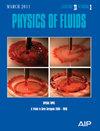旋转粗糙表面微通道中的电磁流体力学流动和热性能
IF 4.1
2区 工程技术
Q1 MECHANICS
引用次数: 0
摘要
微通道中的粗糙表面可有效增强电驱动微流体设备中的液体混合、热性能和化学反应。带有表面粗糙度的微通道旋转会加强这种增强效果。我们研究了电磁流体力学和表面粗糙度对微通道中瞬态旋转流动的综合影响。我们提出了一个数学模型,其中考虑了微通道内可变的 zeta 电位、传热特性和熵的产生。我们利用变量分离法和傅里叶级数展开法获得了解析解。微通道的表面粗糙度与旋转相结合,会影响温度的提升。较高的旋转率会形成多个涡流。二次流将一次流速推向边界层,从而影响流动模式。表面粗糙度和电渗流对二次流有显著影响,导致复杂的流动模式和逆转。离心力和粘性力的相互作用导致边界层的速度达到最大值。较高的粗糙度和电磁效应会加剧流固摩擦和焦耳热,从而提高温度。表面粗糙度会增加壁面剪应力和摩擦因数,从而导致更高的波瓦数。此外,尽管传热得到改善,但表面粗糙会加强流体混合和内部摩擦,从而增加熵的产生。由于二次流引起的额外涡流,较高的旋转也会增加熵的产生。本文章由计算机程序翻译,如有差异,请以英文原文为准。
Electromagnetohydrodynamic flow and thermal performance in a rotating rough surface microchannel
Rough surfaces in microchannels effectively enhance liquid mixing, thermal performance, and chemical reactions in electrically actuated microfluidic devices. Rotation of the microchannel with surface roughness intensifies this enhancement. We investigate the combined effects of electromagnetohydrodynamics and surface roughness on transient rotating flow in microchannels. We present a mathematical model considering the variable zeta potential, heat transfer characteristics, and entropy generation within the microchannel. We obtain analytical solutions using the separation of variables method and Fourier series expansion. The surface roughness of the microchannel, when combined with rotation, impacts the temperature enhancement. Higher rotation rates result in the formation of multiple vortices. The secondary flow pushes the primary velocity toward the boundary layer, which affects the flow pattern. Surface roughness and electroosmotic flow significantly affect secondary flow, resulting in complex flow patterns and reversals. The interaction between centrifugal and viscous forces results in maximum velocities at the boundary layers. Higher roughness and electromagnetic effects enhance temperature by intensifying fluid-solid friction and joule heating. Surface roughness causes an increase in wall shear stress and friction factor, resulting in a higher Poiseuille number. Moreover, surface roughness increases entropy production by enhancing fluid mixing and internal friction despite improved heat transfer. Higher rotation also elevates entropy generation due to additional vortices induced by secondary flow.
求助全文
通过发布文献求助,成功后即可免费获取论文全文。
去求助
来源期刊

Physics of Fluids
物理-力学
CiteScore
6.50
自引率
41.30%
发文量
2063
审稿时长
2.6 months
期刊介绍:
Physics of Fluids (PoF) is a preeminent journal devoted to publishing original theoretical, computational, and experimental contributions to the understanding of the dynamics of gases, liquids, and complex or multiphase fluids. Topics published in PoF are diverse and reflect the most important subjects in fluid dynamics, including, but not limited to:
-Acoustics
-Aerospace and aeronautical flow
-Astrophysical flow
-Biofluid mechanics
-Cavitation and cavitating flows
-Combustion flows
-Complex fluids
-Compressible flow
-Computational fluid dynamics
-Contact lines
-Continuum mechanics
-Convection
-Cryogenic flow
-Droplets
-Electrical and magnetic effects in fluid flow
-Foam, bubble, and film mechanics
-Flow control
-Flow instability and transition
-Flow orientation and anisotropy
-Flows with other transport phenomena
-Flows with complex boundary conditions
-Flow visualization
-Fluid mechanics
-Fluid physical properties
-Fluid–structure interactions
-Free surface flows
-Geophysical flow
-Interfacial flow
-Knudsen flow
-Laminar flow
-Liquid crystals
-Mathematics of fluids
-Micro- and nanofluid mechanics
-Mixing
-Molecular theory
-Nanofluidics
-Particulate, multiphase, and granular flow
-Processing flows
-Relativistic fluid mechanics
-Rotating flows
-Shock wave phenomena
-Soft matter
-Stratified flows
-Supercritical fluids
-Superfluidity
-Thermodynamics of flow systems
-Transonic flow
-Turbulent flow
-Viscous and non-Newtonian flow
-Viscoelasticity
-Vortex dynamics
-Waves
 求助内容:
求助内容: 应助结果提醒方式:
应助结果提醒方式:


